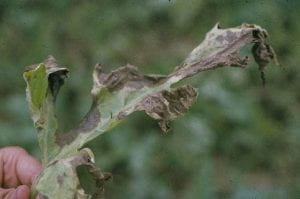Kate Everts, Vegetable Pathologist, University of Delaware and University of Maryland; keverts@umd.edu
Gummy stem blight (caused by Didymella bryoniae) is the most important foliar disease of watermelon in Maryland and Delaware. The disease affects leaves (Fig. 1), stems and vines of watermelon, resulting in fewer and smaller fruit. Anthracnose (Fig. 2), which is caused by Colletotrichum orbiculare, also occurs yearly. In MD and DE, yield losses due to gummy stem blight and anthracnose of 20 to 100% would occur in the absence of effective fungicidal control.
Beginning in 1997 the DE IPM, MAR-DEL Watermelon growers, Maryland Vegetable growers, and other grant funds have supported dissemination of a weather-based fungicide application program for watermelons, Melcast. Melcast is a weather-based spray advisory program for watermelon developed at Purdue University. The program uses hours of leaf wetness and temperature during leaf wetness periods to determine when a fungicide should be applied. In MD and DE, we have slightly modified Melcast so that fungicides are scheduled earlier. As a result, fungicides scheduled by Melcast, successfully manage anthracnose and gummy stem blight. Growers that use Melcast report reducing their fungicide applications by two per season compared to standard schedules. Six research trials were conducted over three years in our region to evaluate Melcast. In four of those trials yield was the same when sprays were applied according to Melcast compared to weekly applications. In one trial yield was higher, and in one trial yield was lower, when sprayed according to Melcast in comparison to weekly sprays.
Since our original trials of Melcast, several newer and highly effective fungicides have been registered for gummy stem blight and anthracnose. We are testing Melcast again with these effective materials. To use Melcast on your farm, please call Karen Adams at (302)856-7303 and give us your name and Fax number or e-mail address. More details about how the program works are available at our Disease Forecasting Web page: http://mdvegdisease.umd.edu/forecasting/index.cfm
Figure 1. Large dark brown foliar lesions of gummy stem blight
Figure 2. Anthracnose lesions on cucurbits are angular in appearance. Tiny black spots can be seen through a hand lens in the tan centers of lesions.


